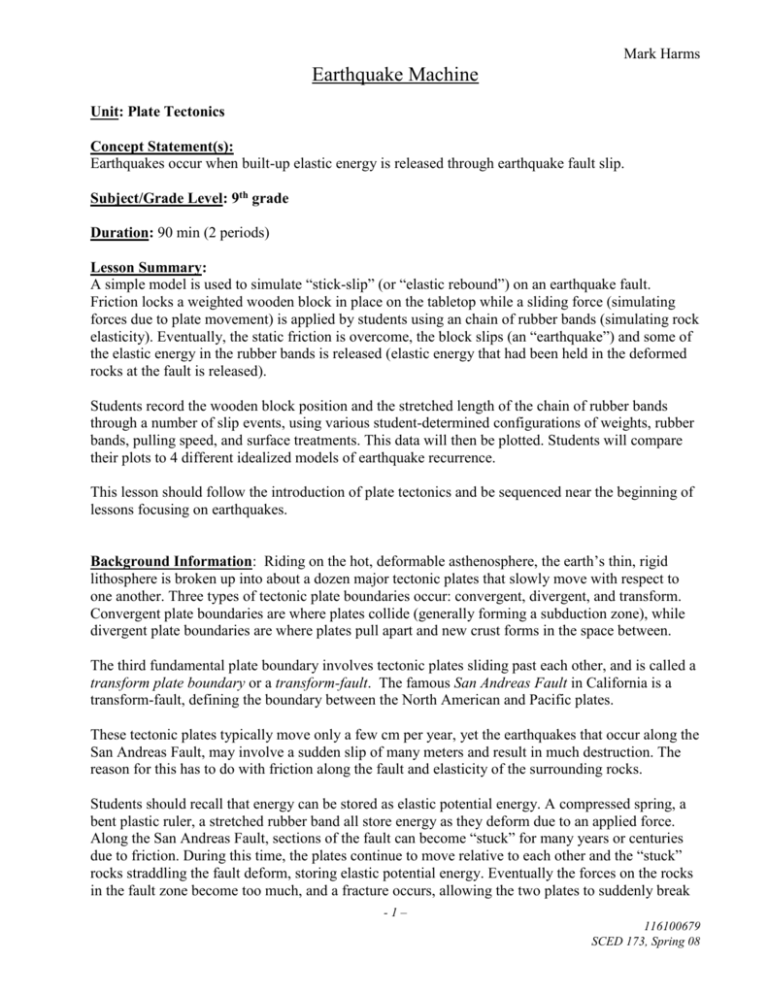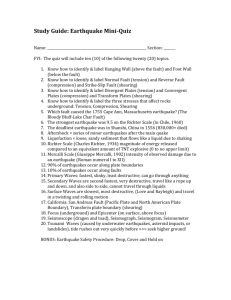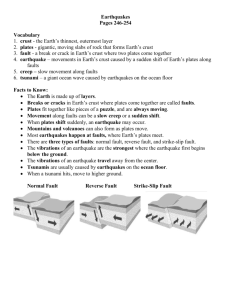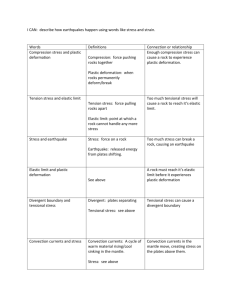Earthquake Machine
advertisement

Mark Harms Earthquake Machine Unit: Plate Tectonics Concept Statement(s): Earthquakes occur when built-up elastic energy is released through earthquake fault slip. Subject/Grade Level: 9th grade Duration: 90 min (2 periods) Lesson Summary: A simple model is used to simulate “stick-slip” (or “elastic rebound”) on an earthquake fault. Friction locks a weighted wooden block in place on the tabletop while a sliding force (simulating forces due to plate movement) is applied by students using an chain of rubber bands (simulating rock elasticity). Eventually, the static friction is overcome, the block slips (an “earthquake”) and some of the elastic energy in the rubber bands is released (elastic energy that had been held in the deformed rocks at the fault is released). Students record the wooden block position and the stretched length of the chain of rubber bands through a number of slip events, using various student-determined configurations of weights, rubber bands, pulling speed, and surface treatments. This data will then be plotted. Students will compare their plots to 4 different idealized models of earthquake recurrence. This lesson should follow the introduction of plate tectonics and be sequenced near the beginning of lessons focusing on earthquakes. Background Information: Riding on the hot, deformable asthenosphere, the earth’s thin, rigid lithosphere is broken up into about a dozen major tectonic plates that slowly move with respect to one another. Three types of tectonic plate boundaries occur: convergent, divergent, and transform. Convergent plate boundaries are where plates collide (generally forming a subduction zone), while divergent plate boundaries are where plates pull apart and new crust forms in the space between. The third fundamental plate boundary involves tectonic plates sliding past each other, and is called a transform plate boundary or a transform-fault. The famous San Andreas Fault in California is a transform-fault, defining the boundary between the North American and Pacific plates. These tectonic plates typically move only a few cm per year, yet the earthquakes that occur along the San Andreas Fault, may involve a sudden slip of many meters and result in much destruction. The reason for this has to do with friction along the fault and elasticity of the surrounding rocks. Students should recall that energy can be stored as elastic potential energy. A compressed spring, a bent plastic ruler, a stretched rubber band all store energy as they deform due to an applied force. Along the San Andreas Fault, sections of the fault can become “stuck” for many years or centuries due to friction. During this time, the plates continue to move relative to each other and the “stuck” rocks straddling the fault deform, storing elastic potential energy. Eventually the forces on the rocks in the fault zone become too much, and a fracture occurs, allowing the two plates to suddenly break -1– 116100679 SCED 173, Spring 08 Mark Harms free of each other, releasing their stored elastic energy in the form of heat and vibrations (seismic waves). This process of sticking and slipping is called stick-slip or elastic rebound. Stick-slip or elastic rebound Earthquake prediction has long been a goal of seismologists. This activity should give students some insight into what earthquake prediction may entail and the difficulties involved. Students should recall (perhaps with prompting/review) the concepts related to energy (elastic energy, in particular) and friction. Students should have previously learned about the earth’s interior, types of tectonic plate boundaries and should know where earthquakes tend to occur. Extension activities require ability to solve problems using logs and exponential functions. California Science Standard(s): Dynamic Earth Processes 3. Plate tectonics operating over geologic time has changed the patterns of land, sea, and mountains on Earth’s surface. As the basis for understanding this concept: d. Students know why and how earthquakes occur and the scales used to measure their intensity and magnitude. California Geology 9. The geology of California underlies the state’s wealth of natural resources as well as its natural hazards. As a basis for understanding this concept: b. Students know the principal natural hazards in different California regions and the geologic basis of those hazards. Investigation and Experimentation 1. Scientific progress is made by asking meaningful questions and conducting careful investigations. As a basis for understanding this concept and addressing the content in the other four strands, students should develop their own questions and perform investigations. Students will: d. Formulate explanations by using logic and evidence. g. Recognize the usefulness and limitations of models and theories as scientific representations of reality. Student Objectives: Students will be able to Declarative knowledge (content) Model the occurrence of earthquakes using a stick-slip model Understand how the stored elastic energy in a locked fault is released due to elastic rebound Contrast the model in the activity with what really happens in the real world Procedural knowledge (skills) -2– 116100679 SCED 173, Spring 08 Mark Harms Plot data and compare it to reference plots Make inferences from plotted data New Vocabulary/Definitions: Creep: Slow, steady fault movement Elasticity: The property of returning to an initial form following deformation. Elastic rebound: As plates move, elastic strain energy builds along edges, until rocks rupture and return to their undeformed shapes. Strain: deformation of the earth. Static friction: The force between two objects that are not moving relative to each other. Stress: A force applied over an area Stick-slip: Adjacent surfaces alternating between sticking to each other and sliding past each other. Formative Assessment: Student Activity Sheet questions will be worked during the activity and a quiz follows up the lesson. Summative Assessment: If a section of the San Andreas fault is continuousy “creeping”, what does this say about the probability of a major earth quake occuring on that section? TEACHER PREPARATION Materials: Per Group (3 or 4 students per group): wood block (roughly 8cm x 12cm, thickness >1cm) sheet of extra-fine (>180 grit, approx 7cm x 13cm)) adhesive sand paper (affix to bottom of wood block) miniature screw-eye (eye bolt) weights (large nuts, washers work well) 5-10 rubber bands (size 16, approx. 4cm diam.) meter stick or metric measuring tape Long (>1.5m), hard-top table (Formica or similar hard surface). Note: sandpaper not recommended for wood tabletop surfaces 1m length of butcher paper (or similar). If tabletop needs to be protected, tape a long (>1m) strip to the tabletop and use it as a “runway” for the wood block. Optional: Scale for weighing weights. Otherwise pre-weigh and label weights. Optional: Card stock or construction paper to make “building” (for dramatic effect) Per Student Student Activity Sheet Quiz Sheet Shared Materials: masking tape (to hold weights in place on wood block -3– 116100679 SCED 173, Spring 08 Mark Harms Scissors ( stapler, double-sided tape, or glue for “building” construction Advance Preparation; Assemble components: Insert screw eye into side of wood block. Fig1. Wood block with screw eye Attach adhesive-backed 180 grit sandpaper to the underside of the wood block. Assemble rubber band string (5 bands or adjust as needed). If there is time, allow students to do this step. Fig. 2. 5 piece rubber band string Gather up weights (large hex nuts, washers, etc.) to be secured to the top of the wood block with masking tape. If time is a concern, pre-weigh the weights and label them accordingly. Otherwise secure scales to allow students to do the weighing themselves. Target the total weight of block + weights at 180g (assuming 5 rubber bands in the rubber band string, 8cm x 12 cm wood block with 180 grit sandpaper taped to the bottom for friction). Test the setup prior to the classroom activity. Make adjustments, if necessary, so several slip-events occur over a span of 50cm. Supply student groups with a configuration likely to work well. Write the vocabulary words and definitions on the front board prior to the activity. Safety Considerations: The wood block may be launched off the table if the weights fall off during the pulling of the rubber band string. Weights should be securely taped to the wood block so they do not fall off. Rubber bands may break. Safety goggles are advised for younger students. Potential splinter hazard from wood blocks. Sand wood edges and have first aid kit available during activity. Accommodations for Special Needs Students: ELL students can be given directions by way of a teacher demonstration. Working groups that contain ELL students should also include a student who can act as an interpreter, if possible. A more graphically-oriented Student Activity Sheet can be prepared for ELL and Visual Learners. Special Needs students requiring cognitive assistance should be teamed with a helper partner and may have portions of the Student Activity Sheet filled-out in advance. -4– 116100679 SCED 173, Spring 08 Mark Harms REFERENCES Lesson adapted by Mark Harms from: http://jclahr.com/science/earth_science/tabletop/earthshaking/index.html http://www.iris.edu/edu/EQliteActivity1.htm http://www.iris.edu/about/ENO/aotw/archive/1/ Various versions of the sliding block “Earthquake Machine”: http://jclahr.com/science/earth_science/tabletop/index.html http://quake.wr.usgs.gov/research/deformation/modeling/eqmodel.html Magnitude vs. energy equations: http://jclahr.com/science/earth_science/cr06/festival/magnitude.doc http://www.cientec.or.cr/matematica/pdf/magnitude.pdf Animation of recent California earthquakes: http://quake.wr.usgs.gov/recenteqs/Anim/canv.html Illustrations: http://pubs.usgs.gov/gip/dynamic/Vigil.html -5– 116100679 SCED 173, Spring 08









